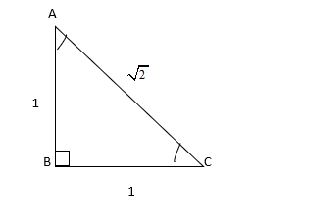
How do you evaluate sine, cosine, tangent of \[\dfrac{\pi }{4}\] without using a calculator?
Answer
544.5k+ views
Hint:In the above question, is based on the concept of trigonometry. The sine, cosine, tangent functions can be solved by solving the relationship between angles and sides of the triangle.
Using \[\dfrac{\pi }{4}\] as the angle we can find the length of sides to get the value of each function.
Complete step by step solution:
Given is the angle which is \[\dfrac{\pi }{4}\] or \[{45^ \circ }\].So to solve the value of functions, we
need to know that one angle in the triangle is always \[{90^ \circ }\].Since we want to find the function for the angle for \[{45^ \circ }\],so the other angle in the triangle is \[{45^ \circ }\].
The total angle of triangle is \[{180^ \circ }\].Therefore by adding two angles and subtracting it with
\[{180^ \circ }\] we get a third angle.
\[{180^ \circ } - ({90^ \circ } + {45^ \circ }) = {45^ \circ }\].

So, we consider the unit triangle \[\vartriangle ABC\]where two sides are equal. Since the two sides of triangles are equal, the triangle is an isosceles triangle. Therefore, by applying Pythagoras theorem, we
get \[AC = \sqrt {A{B^2} + B{C^2}} = \sqrt {{1^2} + {1^2}} = \sqrt 2 \]
Now, we have to apply the trigonometric properties for different functions. For sine function the formula is the opposite side divided by hypotenuse.
\[\sin {45^ \circ } = \dfrac{1}{{\sqrt 2 }}\]
For cosine function, the formula is adjacent side divided by hypotenuse. Therefore, we get
\[\cos {45^ \circ } = \dfrac{1}{{\sqrt 2 }}\]
For tangent function, the formula is sine function divided by cosine function. \[\]
\[\tan {45^ \circ } = \dfrac{{\dfrac{1}{{\sqrt 2 }}}}{{\dfrac{1}{{\sqrt 2 }}}} = 1\]
Therefore, we get the above values.
Note: An important thing to note is that \[\dfrac{1}{{\sqrt 2 }}\] can also be further solved to get a decimal numbers.So, rationalizing it with \[\sqrt 2 \],we get \[\dfrac{1}{{\sqrt 2 }} \times \dfrac{{\sqrt 2 }}{{\sqrt 2 }} = \dfrac{{\sqrt 2 }}{2}\].The value of \[\sqrt 2 \]is 1.414,therefore dividing it by 2 we get
0.707.
Using \[\dfrac{\pi }{4}\] as the angle we can find the length of sides to get the value of each function.
Complete step by step solution:
Given is the angle which is \[\dfrac{\pi }{4}\] or \[{45^ \circ }\].So to solve the value of functions, we
need to know that one angle in the triangle is always \[{90^ \circ }\].Since we want to find the function for the angle for \[{45^ \circ }\],so the other angle in the triangle is \[{45^ \circ }\].
The total angle of triangle is \[{180^ \circ }\].Therefore by adding two angles and subtracting it with
\[{180^ \circ }\] we get a third angle.
\[{180^ \circ } - ({90^ \circ } + {45^ \circ }) = {45^ \circ }\].

So, we consider the unit triangle \[\vartriangle ABC\]where two sides are equal. Since the two sides of triangles are equal, the triangle is an isosceles triangle. Therefore, by applying Pythagoras theorem, we
get \[AC = \sqrt {A{B^2} + B{C^2}} = \sqrt {{1^2} + {1^2}} = \sqrt 2 \]
Now, we have to apply the trigonometric properties for different functions. For sine function the formula is the opposite side divided by hypotenuse.
\[\sin {45^ \circ } = \dfrac{1}{{\sqrt 2 }}\]
For cosine function, the formula is adjacent side divided by hypotenuse. Therefore, we get
\[\cos {45^ \circ } = \dfrac{1}{{\sqrt 2 }}\]
For tangent function, the formula is sine function divided by cosine function. \[\]
\[\tan {45^ \circ } = \dfrac{{\dfrac{1}{{\sqrt 2 }}}}{{\dfrac{1}{{\sqrt 2 }}}} = 1\]
Therefore, we get the above values.
Note: An important thing to note is that \[\dfrac{1}{{\sqrt 2 }}\] can also be further solved to get a decimal numbers.So, rationalizing it with \[\sqrt 2 \],we get \[\dfrac{1}{{\sqrt 2 }} \times \dfrac{{\sqrt 2 }}{{\sqrt 2 }} = \dfrac{{\sqrt 2 }}{2}\].The value of \[\sqrt 2 \]is 1.414,therefore dividing it by 2 we get
0.707.
Recently Updated Pages
Why are manures considered better than fertilizers class 11 biology CBSE

Find the coordinates of the midpoint of the line segment class 11 maths CBSE

Distinguish between static friction limiting friction class 11 physics CBSE

The Chairman of the constituent Assembly was A Jawaharlal class 11 social science CBSE

The first National Commission on Labour NCL submitted class 11 social science CBSE

Number of all subshell of n + l 7 is A 4 B 5 C 6 D class 11 chemistry CBSE

Trending doubts
What is meant by exothermic and endothermic reactions class 11 chemistry CBSE

10 examples of friction in our daily life

One Metric ton is equal to kg A 10000 B 1000 C 100 class 11 physics CBSE

1 Quintal is equal to a 110 kg b 10 kg c 100kg d 1000 class 11 physics CBSE

Difference Between Prokaryotic Cells and Eukaryotic Cells

What are Quantum numbers Explain the quantum number class 11 chemistry CBSE




